Jiri, 1905m (6250ft)
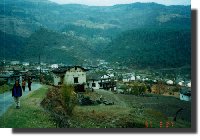 The bus to Jiri is quite a ride. Luckily we had read some info at KEEP,
so we were a little prepared for the adventure. We bought three seats in
the bus (for like US$2 each), but the seats were hardly reserved for us.
The bus made frequent stops and people would jump on and off anywhere
that they could find room. We kept our bags in our seat with us, because
we heard that the people riding on top of the bus might take our stuff if
we left it up there. Anyway, we were able to guard our space throughout
the day. We probably could have relaxed a little more and enjoyed the
ride, but it is definitely not for the faint of heart.
The bus to Jiri is quite a ride. Luckily we had read some info at KEEP,
so we were a little prepared for the adventure. We bought three seats in
the bus (for like US$2 each), but the seats were hardly reserved for us.
The bus made frequent stops and people would jump on and off anywhere
that they could find room. We kept our bags in our seat with us, because
we heard that the people riding on top of the bus might take our stuff if
we left it up there. Anyway, we were able to guard our space throughout
the day. We probably could have relaxed a little more and enjoyed the
ride, but it is definitely not for the faint of heart.
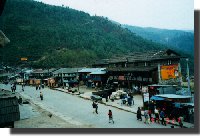 We arrived in Jiri at dusk. We got our first taste of the
countryside life as we stepped off the bus. There were many people vying
for the tourist dollars (or rupees) of the few foreigners on the bus: us,
a lone Australian named Simon, and two Canadians, Dana and Eric. Along
with Australians John and Dale who arrived by hired car, we five made up
a hiking group that would spend a lot of time together over the next
week. We also met other people along the way who were all going to the
same place: for a view of Everest.
We arrived in Jiri at dusk. We got our first taste of the
countryside life as we stepped off the bus. There were many people vying
for the tourist dollars (or rupees) of the few foreigners on the bus: us,
a lone Australian named Simon, and two Canadians, Dana and Eric. Along
with Australians John and Dale who arrived by hired car, we five made up
a hiking group that would spend a lot of time together over the next
week. We also met other people along the way who were all going to the
same place: for a view of Everest.
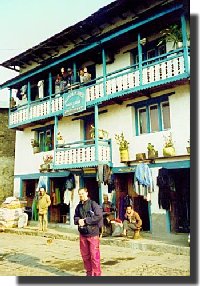 We chose the Mt. Everest Lodge
because the kids running the place (none of
them over 16 years of age) seemed nice. We paid less than 20cents for
our beds that night. This is pretty much the standard in the lower
hills. The lodge owners make their money from the dinner and breakfast
that they prepare for you. There are no Pizza Huts or McDonald's
around, so generally you get to eat at your little bed and breakfast. It
was a little cool already that first night, but the real adventure
started on the 28th.
We chose the Mt. Everest Lodge
because the kids running the place (none of
them over 16 years of age) seemed nice. We paid less than 20cents for
our beds that night. This is pretty much the standard in the lower
hills. The lodge owners make their money from the dinner and breakfast
that they prepare for you. There are no Pizza Huts or McDonald's
around, so generally you get to eat at your little bed and breakfast. It
was a little cool already that first night, but the real adventure
started on the 28th.
March 28: Jiri to Bhandar
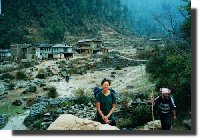 That first day of walking was a killer. It didn't take long before
Brica let me carry her big backpack and she took the bookbag. These
trails would be hard even without any gear. In fact, many people hire
porters to carry their gear for them. We thought that a couple of young
healthy kids could handle the gear, but it was definitely a challenge.
We walked over nine hours that first day. Lots of ups and downs as we
started to make our way into the valleys and over the passes that make up
the Khumbu region. Check out this Khumbu Map that
shows the three major passes that we had to cross to get from Jiri to
Namche. That first day we climbed from 1905m (6250ft) up to a pass at
2713m (8900ft) and then back again to the town of Bhandar. We saw
some of the most amazing step
farms during that first day of walking. We met a couple Israeli guys
who were already arguing with each other about the best speed to hike.
It was a long day, but it was worth it when we got into Bhandar at 5:30.
That first day of walking was a killer. It didn't take long before
Brica let me carry her big backpack and she took the bookbag. These
trails would be hard even without any gear. In fact, many people hire
porters to carry their gear for them. We thought that a couple of young
healthy kids could handle the gear, but it was definitely a challenge.
We walked over nine hours that first day. Lots of ups and downs as we
started to make our way into the valleys and over the passes that make up
the Khumbu region. Check out this Khumbu Map that
shows the three major passes that we had to cross to get from Jiri to
Namche. That first day we climbed from 1905m (6250ft) up to a pass at
2713m (8900ft) and then back again to the town of Bhandar. We saw
some of the most amazing step
farms during that first day of walking. We met a couple Israeli guys
who were already arguing with each other about the best speed to hike.
It was a long day, but it was worth it when we got into Bhandar at 5:30.
Bhandar 2194m (7200ft)
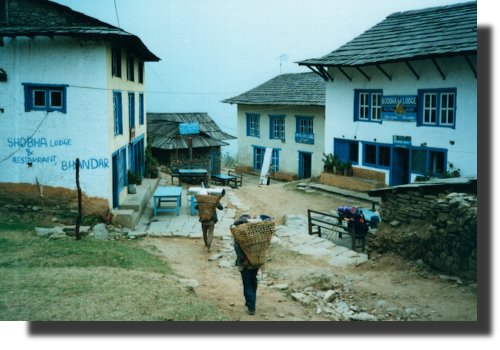 We chose the Shobha Lodge and Restaurant (don't let the name fool
you) for our second night in the countryside. We got two of the same
20cent beds. We both opted for the hot shower which cost extra. The
water was heated by a wood fire in the kitchen. I was sure that the cook
could see me through the cracks of the shower-room wall, but I didn't
care. This would be my last shower for over a week, so I tried to enjoy
it. Hot showers are luxuries that the forest can't afford for the
thousands of trekkers who come through. The rest of the trip, we simply
splashed a little cold water on the face and feet each morning- that was
enough to keep you going.
We chose the Shobha Lodge and Restaurant (don't let the name fool
you) for our second night in the countryside. We got two of the same
20cent beds. We both opted for the hot shower which cost extra. The
water was heated by a wood fire in the kitchen. I was sure that the cook
could see me through the cracks of the shower-room wall, but I didn't
care. This would be my last shower for over a week, so I tried to enjoy
it. Hot showers are luxuries that the forest can't afford for the
thousands of trekkers who come through. The rest of the trip, we simply
splashed a little cold water on the face and feet each morning- that was
enough to keep you going.
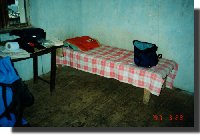 The Shobha Lodge had a TV. It was probably the only TV in about a
ten mile radius, so the place was pretty popular at night. I wasn't
quite sure what kind of channels we were picking up on the satellite dish,
but it somehow seemed wrong. TV is a big step toward convincing the
people of the countryside that they need to have a lot more things. One
friend told of Thai people selling their daughters for televisions,
though I think that story was exaggerated. Anyway, the Shoba Lodge had
more services than most places we visited.
The Shobha Lodge had a TV. It was probably the only TV in about a
ten mile radius, so the place was pretty popular at night. I wasn't
quite sure what kind of channels we were picking up on the satellite dish,
but it somehow seemed wrong. TV is a big step toward convincing the
people of the countryside that they need to have a lot more things. One
friend told of Thai people selling their daughters for televisions,
though I think that story was exaggerated. Anyway, the Shoba Lodge had
more services than most places we visited.
March 29: Bhandar to Sete
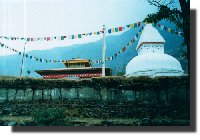 After Bhandar we entered the region inhabitated by the Sherpa people. It seems that Sherpa has become the universal word for "porter" due to their fame on many Everest treks. However, the term actually refers to a ethnic group that lives throughout this region of the Himalaya. As we walked out of the village in the morning, we came across a beatiful example of temple grounds including a gomba and a stupa. My understanding is that the beliefs here are a mixture of Buddhist and
After Bhandar we entered the region inhabitated by the Sherpa people. It seems that Sherpa has become the universal word for "porter" due to their fame on many Everest treks. However, the term actually refers to a ethnic group that lives throughout this region of the Himalaya. As we walked out of the village in the morning, we came across a beatiful example of temple grounds including a gomba and a stupa. My understanding is that the beliefs here are a mixture of Buddhist and
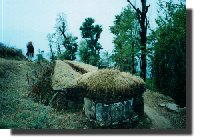 Hindu teachings. The original Buddha himself (Siddhartha Gautama) was from Nepal, but I think Buddhism caught on more through China (India remains mostly Hindi) and into Southeast Asia, Korea, and Japan. Anyway, we also came upon some mani walls which are quite common along the trail here. Without an English guide we are unable to ascertain the exact meaning of some of this stuff, but appreciate it for its age and beauty nonetheless.
Hindu teachings. The original Buddha himself (Siddhartha Gautama) was from Nepal, but I think Buddhism caught on more through China (India remains mostly Hindi) and into Southeast Asia, Korea, and Japan. Anyway, we also came upon some mani walls which are quite common along the trail here. Without an English guide we are unable to ascertain the exact meaning of some of this stuff, but appreciate it for its age and beauty nonetheless.
Some of the photographs from the region make things look pretty primitave at first. However, one can not really say that the region is not developed. Even some of the steepest hillsides have been terraced for farming. Also, thanks to many hikers who pass through, there are many new teahouses and residences being built all the time.
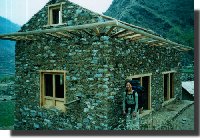 The construction techniques are really amazing to me. Rocks are more abundant than trees around here, so the walls are generally all rock. Window frames and roofing are made from carefully crafted wood. The people don't need much money, so between the crops, the resources, and the trekking busines, the region is generally more prosperous than other areas in Nepal.
The construction techniques are really amazing to me. Rocks are more abundant than trees around here, so the walls are generally all rock. Window frames and roofing are made from carefully crafted wood. The people don't need much money, so between the crops, the resources, and the trekking busines, the region is generally more prosperous than other areas in Nepal.
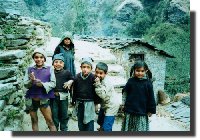 Even so, one cannot help but feel sorry for people sometimes. Almost all of the kids you meet on the trail will greet you with "Hello, pen?" I don't understand why they all ask for pens, but I think it is still best not to give anything. My experience is that people are generally happy wherever they live. They may not have all of the fancy toys that we have in the highly developed nations, but they have what they want and it is best that we don't tempt them with silly toys from our world. Anyway, a trek in Nepal is more than just walking over the hills...
Even so, one cannot help but feel sorry for people sometimes. Almost all of the kids you meet on the trail will greet you with "Hello, pen?" I don't understand why they all ask for pens, but I think it is still best not to give anything. My experience is that people are generally happy wherever they live. They may not have all of the fancy toys that we have in the highly developed nations, but they have what they want and it is best that we don't tempt them with silly toys from our world. Anyway, a trek in Nepal is more than just walking over the hills...
Sete 2575m (8450ft)
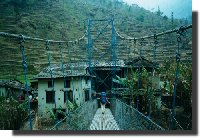 After dropping down to the river, we begin what will be a two-day climb from 1543m to 3530m in order to cross our second big pass of the trip, Lamjura Pass (see map). Rain started to set in early in the afternoon just as we walked into Sete. The little teahouse there was comfortable enough and there were some other friendly people who had trickled in. We all decided to call it a night there and save our clothes from getting too wet.
After dropping down to the river, we begin what will be a two-day climb from 1543m to 3530m in order to cross our second big pass of the trip, Lamjura Pass (see map). Rain started to set in early in the afternoon just as we walked into Sete. The little teahouse there was comfortable enough and there were some other friendly people who had trickled in. We all decided to call it a night there and save our clothes from getting too wet.
March 30: Sete to Junbesi
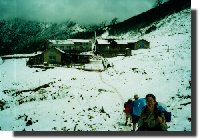 We set off in the morning with our new-found friends. Actually I don't even remember when or how the group got together, but we came to know a mother and two daughters from Australia, an older country from the same, and a younger couple from Canada. We were all surprised that only a few hundred meters up the trail last nights rain was snow. We spent the whole morning climbing through this winter wonderland until we reached the top of Lamjura Pass. Overall it was a hard climb, so it was best that we did it in two days. It was also nice to share the walk with some friends.
We set off in the morning with our new-found friends. Actually I don't even remember when or how the group got together, but we came to know a mother and two daughters from Australia, an older country from the same, and a younger couple from Canada. We were all surprised that only a few hundred meters up the trail last nights rain was snow. We spent the whole morning climbing through this winter wonderland until we reached the top of Lamjura Pass. Overall it was a hard climb, so it was best that we did it in two days. It was also nice to share the walk with some friends.
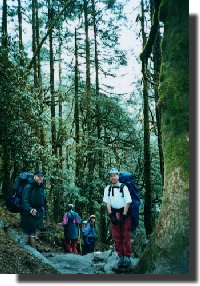 Down the backside of the pass we walked through some beautiful thick forest. Aside from our small group of trekkers the trail was almost deserted. The locals don't have much reason to cross these passes unless they are carrying supplies or cargo in from Junbesi. The walk at this level of the trail is surprisingly peaceful. And April is supposed to be the prime season for trips to Nepal. The main reason is that many people fly into Lukla thereby skipping some of the lower altitude scenery. I suppose it depends on what you like, but in retrospect, we were complete content to see what we did. Of course next time we will allow enough time for a full walk on one of the longer courses, but given the choice of the high or lowland, I think the low has served us well.
Down the backside of the pass we walked through some beautiful thick forest. Aside from our small group of trekkers the trail was almost deserted. The locals don't have much reason to cross these passes unless they are carrying supplies or cargo in from Junbesi. The walk at this level of the trail is surprisingly peaceful. And April is supposed to be the prime season for trips to Nepal. The main reason is that many people fly into Lukla thereby skipping some of the lower altitude scenery. I suppose it depends on what you like, but in retrospect, we were complete content to see what we did. Of course next time we will allow enough time for a full walk on one of the longer courses, but given the choice of the high or lowland, I think the low has served us well.
Junbesi 2675m (8775ft)
Our other Australia friend, Simon the solo trekker, had gone ahead and reserved us all a bed at the best place in town: Junbesi Guesthouse. There really is quite a difference in the amenities and friendliness of staff depending on the teahouse. The guidebooks will tell you what they recommend. And the locals are always quick to give you a business card describing the merits of their favorite place. But the best way to survive is by listening to other trekkers. Junbesi GH had the usual warm pot of lemon flavored tea, an unusually warm gathering room, and a great bunkroom upstairs which held our whole group and a few others. We got a good rest here and left early the next morning, leaving half of our group behind.
| 











